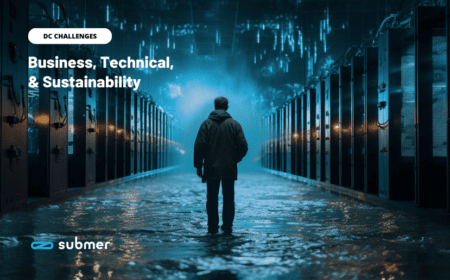After having come across several articles that clearly set out to spread myths about Liquid Immersion Cooling and how difficult adoption, operation and maintenance can be, I would like to address these claims one by one and prove that they are untrue or are delivered with a false pretext. Often Direct Liquid Cooling refers to On-Chip Cooling and I fully understand the reservations people may have towards that specific technology.
The rise of IoT, machine learning and upcoming edge deployment scenarios (such as for self-driving cars and high-frequency trading) may imply higher compute densities which may even be outside the realms of even the most innovative air cooling (pumped refrigerant and rear-door cooling). HPC, Increased Consolidation and Virtualisation are also driving the demand for higher densities, taking us from <10kW to >35kW per rack and above.
We at Submer understand from our Clients and Partners that demand for higher densities are largely coming from their anchor-tenants.
The switch from air to Liquid Immersion Cooling is easier than most imagine, so let’s get on with disproving those falsehoods…
Myth #1. Two Cooling Systems Instead of One
While this may be true of some other liquid cooling variants (like 2-phase or direct-to-chip/cold-plate cooling), with Submer Immersion Cooling’s single-phase solution, Data Center operators can leverage their existing water loops to deliver the secondary cooling, provided they can support steady temperatures. Often existing water loops deliver water at relatively low temperatures (below 16°C) allowing Submer’s SmartPods to dissipate >100kW in a 1m x 1.2m footprint, albeit not necessarily leading to the best possible PUE.
This makes the introduction of Immersion Cooling less of a headache for the facilities team on whose shoulders the task of installing and maintaining will surely fall.
This means that introducing Liquid Immersion Cooling to an existing Data Center is perfectly viable and Submer’s SmartPods are designed to not look out of place in such a setting, often even helping Data Centers leverage unused rooms or space that has not yet been built out for air or even space with otherwise too little headroom.
Myth #2. No Standards
While this myth had some truth to it in the not so distant past, the Industry has started to come together in the form of the Open Compute Project, a project in which Submer takes an active role, in particular in the Advanced Cooling Subgroup. The OCP and its Foundation is looking to standardize how hardware for HPC/HDC is designed and built and wants to ensure maintenance is still easy to carry out.
With Submer, customers can use any OEM or custom hardware with little or no modifications depending on the vendor. Supermicro and Fujitsu have server-lines ready for Immersion Cooling and some other manufacturers provide firmware and/or BIOS updates to let the servers know that fans are not required. In the most extreme cases, Submer provides fan-emulators to trick servers into believing fans are running at a particular frequency.
Furthermore, servers that have been submerged can be fully restored to their original state with a specially crafted cleaning fluid and can even be returned to an air-cooled environment or sold.
Pol Valls, co-founder of Submer, assures us: “Should there be any doubt regarding warranties, rest assured that Submer is working with all top hardware manufacturers such as Cisco, Dell, HPE, Supermicro, Intel, Fujitsu, and more to advance their acceptance, understanding, and support of Immersion Cooling. They are however in most cases large enterprises that take some time to alter their previously set course. We also work with an independent third party that understands Immersion Cooling and helps Submer to honour warranties even in cases where the manufacturer may be difficult.”
Myth #3. Electrocution
Now, this myth can be immediately dispelled for immersion cooling. While direct-to-chip/cold-plate cooling most likely use water, liquid immersion cooling solutions always use some formula of dielectric liquid, which doesn’t conduct electricity and presents no risk of electrocution. You could submerge multiple toasters, hairdryers, stick both your hands in the liquid and only enjoy the moisturizing effect! According to Fluid Thermodynamics Professor, Javier Mesones: “Pure deionized water is also dielectric. The only problem is that any small impurity makes water an amazing conductor of electricity and that’s what it wants to become. It is, however, an amazing transport medium for heat, which is why we at Submer prefer to leverage water for our secondary cooling loop”.
Myth #4. Corrosion
Submer’s synthetic dielectric coolant prevents oxidation, not only as it forms a barrier to moisture present in the air and referring to rust, but also because specific additives in our specially crafted liquid help prevent the destabilization or loss of electrons. Staunch supporter of Immersion Cooling and genius engineer Harold Miyamura of Baidu Research US reports: “Dielectric coolants are a dream in comparison to direct liquid cooling. We at Baidu have tested many configurations and they always lead to corrosion, leaks and hardware failures. They also only address part of the heat equation, not all as with Immersion Cooling. Our lab floor is stained with the rust resulting from failures of such solutions”.
Myth #5. Operational Complexity
This myth I love to dispel as it really is so far from reality. Liquid Immersion Cooling simplifies installation, operations and maintenance. According to Chris Smith – CTO of Flexirax, a Liquid Immersion Cooling only Data Center: “A Liquid Immersion Cooling installation has less components: there are less moving parts, less hardware failures, no particles being propelled through the hardware. Maintenance is easier as a result. DC-Engineers can become familiar very quickly”.
A special thanks to Diarmuid Daltún



